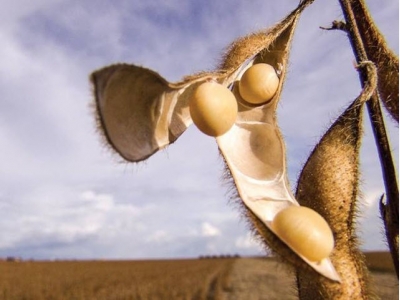Soy protein may replace animal proteins in piglet diets

University of Illinois researchers suggest that soy protein concentrate may substitute for animal proteins in weanling pig diets without adverse effects.
photo by Alffoto | Dreamstime
Results of a University of Illinois (U of I) study indicate that soy protein concentrate (SPC) may be partly or fully substituted for animal proteins in weanling piglet diets without adverse effects on gut health and growth performance.
The article, "Nutritional value of soy protein concentrate ground to different particle sizes and fed to pigs," was published in Journal of Animal Science. The research was funded by Selecta, a biopharmaceutical company that sells SPC.
"We determined digestibility of crude protein, amino acids, and energy in SPC ground to three particle sizes," said study co-author Hans H. Stein, U of I animal sciences professor, in a press release. "We also investigated the effects of substituting SPC for animal proteins on weanling growth performance."
Soy protein concentrate is derived from defatted soy flakes by removing soluble carbohydrates and some non-protein constituents. Three particle sizes - 70, 180, and 700 micrometers - were tested because earlier work showed that particle size of soybean meal affects digestibility of amino acids in weanling pigs.
Soy protein concentrate in piglet diets experimental designs
In the group's first experiment, pigs were fed diets containing soybean meal, fish meal, or SPC ground to one of the three particle sizes. Ileal digesta were collected and analyzed for amino acid and crude protein content.
Standardized ileal digestibility (SID) of crude protein was not different among the three diets containing SPC, but diets with SPC ground to 70 or 180 micrometers had greater crude protein digestibility than the traditional protein sources. The SID of several amino acids, including tryptophan, was also greater in diets containing SPC ground to 70 or 180 micrometers, compared with the other diets.
Stein explains that these results differed from similar studies using soybean meal, in which particle size had a greater influence on digestibility. "It could be that alcohol extraction used in SPC processing improves digestibility, making it unnecessary to reduce particle size further to obtain the same results."
In a second experiment, weanling pigs were fed corn mixed with each of the protein sources used in the first experiment. The goal was to measure apparent total tract digestibility of gross energy and the digestible and metabolizable energy in each diet.
"There were no differences in digestible and metabolizable energy among the three SPC particle sizes, but SPC ground to 180 micrometers contained more digestible energy than corn, soybean meal, and fish meal," Stein said.
Finally, the researchers investigated the effects of SPC on growth performance and blood characteristics. In this experiment, pigs were fed combinations of fish meal, spray-dried protein plasma, and SPC ground to 180 micrometers. The different diets did not change growth performance overall and no reduction in performance was observed if SPC was used instead of fish meal or spray-dried protein plasma.
"Results of this experiment indicated that diets based on soybean meal and SPC can be fed to weanling pigs without negative effects on growth performance during the initial four weeks after weaning," Stein said.
Altogether, results of the three experiments indicate that SPC ground to 180 micrometers may be used as an alternative to animal proteins in weanling pig diets.
Có thể bạn quan tâm
Phần mềm

Phối trộn thức ăn chăn nuôi

Pha dung dịch thủy canh

Định mức cho tôm ăn

Phối trộn phân bón NPK

Xác định tỷ lệ tôm sống

Chuyển đổi đơn vị phân bón

Xác định công suất sục khí

Chuyển đổi đơn vị tôm

Tính diện tích nhà kính

Tính thể tích ao hồ



 Secrets of successful piglet feeding after weaning
Secrets of successful piglet feeding after weaning  Nutrient profile of wheat co-products updated for swine
Nutrient profile of wheat co-products updated for swine